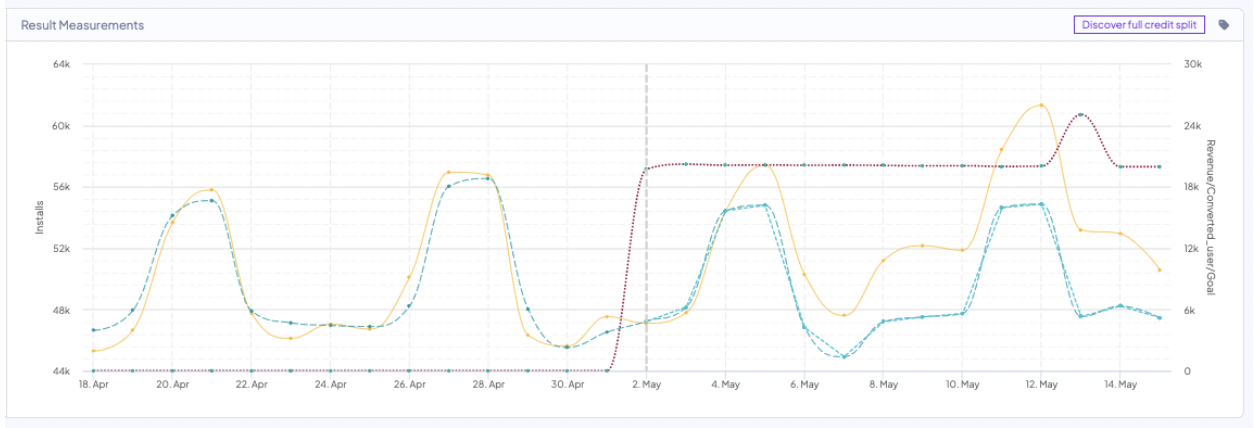CTV Advertising and Measurement: INCRMNTAL x Vibe.co

Television, once fondly referred to as the "small screen" in comparison to cinema, has transformed into a cornerstone of household entertainment. Now the biggest shake up since TV- is CTV (Connected TV). This shift has not only changed the nature of media consumption but also the profound impact CTV has had on audiences and, consequently, on advertising. An impressive 94% of U.S. households own at least one TV streaming device, which will lead to a record breaking $46.9B in CTV ad spend by 2028, officially surpassing traditional TV ad spend.
There are several factors driving this growth:
- More Eyes More Advertising Spend
As CTV viewership grows, advertisers are moving away from linear TV and shifting their ad budgets to a more popular medium. In the US CTV ad spending is projected to increase by 16.8% by the end of the year, while linear TV ad spend is expected to decrease by 15.8%.
2. Data-Driven CTV Targeting
CTV provides advertisers with enhanced addressability. Advertising on CTV is often done using online advertising platforms like Vibe.co, which offer self service tools, allowing an advertiser to launch a TV campaign in minutes, not months. With the right programmatic platform, CTV advertisers can achieve sharper targeting, better personalization, premium inventory access, and precise measurement of their CTV advertising campaigns.
3. Increased Accessibility of CTV Marketing for SMEs
CTV advertising is becoming more accessible to small and medium-sized enterprises. The big screen is no longer exclusive to big-box retailers. Hulu advertising costs just $20-$60 per CPM and programmatic DSPs like Vibe.co can launch campaigns on hundreds of premium channels for just $50/day. Lower CTV advertising costs are encouraging more buyers to experiment with this channel.
4. From Free Content to Ad Fueled
CTV advertising has been on the rise as ad inventories have expanded to premium channels like Disney+, Hulu, or HBO Max. To navigate this new competitive landscape and address subscriber churn, many streaming services that previously vowed never to show ads have introduced ad-supported tiers. Over the past 12 months, nearly all major streaming services now offer an ad-supported option.
The Broad Impact of CTV Advertising
CTV advertising doesn’t operate in a silo; its influence extends across multiple channels and touchpoints.
- Positive Influence on Organics
CTV advertising often generates a "halo effect," leading to increased organic traffic and conversions. Measuring the uplift in organic installs and website visits post-CTV campaign provides insights into the campaign's indirect impact. This method involves comparing organic metrics before, during, and after the CTV campaign to measure incremental lift.
- Halo Effect on Social and Search Channels
CTV campaigns often positively influence other marketing channels, including social media and search engines. By analyzing the performance metrics of these channels in conjunction with CTV campaigns, advertisers can understand their broader impact. For example, a spike in branded search queries or increased engagement on social media can indicate a successful CTV campaign.
Now with all the opportunities that CTV creates the challenge still lies in answering the question: Is my CTV advertising budget successful? To answer this question, you need to ensure your measurement is done right!
Challenges in Measuring CTV Campaigns
The Legacy of Attribution Models
Attribution models in digital advertising typically track user interactions across devices and platforms to assign credit for conversions to specific ads or campaigns. While effective for digital channels when user behavior can be tracked precisely, these models fall short in the context of CTV. The primary reasons for this shortfall include:
- Multi-Device Viewing: Viewers often watch CTV content on different devices, including smart TVs, tablets, and smartphones. This multi-device viewing complicates tracking, as traditional attribution models struggle to connect interactions across these varied platforms.
- Privacy Regulations: Increasing privacy regulations limit the ability to track individual user data, making it difficult to apply traditional attribution models to CTV advertising.
- Indirect Influence: CTV ads often have an indirect influence on consumer behavior, enhancing brand perception and driving future actions that are not immediately measurable through direct conversions.
The Causality Approach: A Superior Measurement Method
Today, as smartphones and hand held devices become ubiquitous, what was once considered the small screen has become a "large screen." The impact of TV ads can also be pretty large.
Given the limitations of traditional tracking methods, the most effective way to measure CTV campaign performance is through a causality approach. This method focuses on understanding the broader impact of TV advertising on various marketing metrics and consumer behaviors, rather than trying to attribute individual conversions to specific ads. A causality-focused measurement approach is so important because TV impacts everything!
How the Causality Approach Works
The causality approach involves establishing a cause-and-effect relationship between CTV ad exposure and subsequent changes in key performance indicators (KPIs). This method acknowledges that CTV advertising impacts everything from brand awareness to search and social media activity. Here’s how it works:
- Baseline Establishment: Before launching a CTV campaign, marketers establish baseline performance metrics for their key indicators, such as website traffic, search volume, app installs, and social media engagement.
- Campaign Launch and Monitoring: The CTV campaign is launched, and performance metrics are continuously monitored. Marketers look for changes in these metrics that align with the timing and reach of the ads.
- Comparative Analysis: By comparing the post-campaign metrics with the established baseline, marketers can identify any lifts in performance that are likely attributable to the CTV campaign. This comparative analysis helps isolate the impact of TV ads from other marketing activities.
- Always-on Incrementality Measurement: To further validate the impact, incrementality measurement can be employed. This method involves integrating CTV measurement with all other paid marketing activities, providing a comprehensive view of the campaign's effectiveness. By establishing a causality connection between CTV campaigns and performance improvements, advertisers can make data-driven decisions and optimize their marketing strategies.
Let’s take a closer look:
A typical CTV measurement using INCRMNTAL may show incremental results that is 3x more than what legacy attribution data shows:

This is due to the fact that attribution looks at conversions that used a tracking link, or were identified using some sort of user level data matching between mobile devices and smart TVs.

INCRMNTAL measures the causal relationship between TV campaign starting, and the incremental results, regardless of if those end up attributed with search traffic, social traffic, or miscategorized as organic conversions.

Conclusion
With the right partner, CTV advertising is a great way for marketers to reach engaged audiences with high-impact video ads, but, legacy tracking tools and attribution models fall short in capturing the true impact of CTV advertising. By leveraging advanced measurement techniques such as incrementality measurement, advertisers can unlock the true potential of CTV advertising.
INCRMNTAL specializes in providing sophisticated measurement solutions for CTV campaigns, ensuring that advertisers can accurately assess their performance and make informed decisions.
Ready to give it a try? Book a demo!
Author Bio: Maor Sadra is the CEO & Co-Founder at INCRMNTAL. With over 20 years of experience in the adtech and marketing technology space, Maor is well known as a thought leader in the areas of marketing measurement. Previously acting as Managing Director International at Inneractive (acquired by Fyber), and as CEO at Applift (acquired by MGI/Verve Group)


